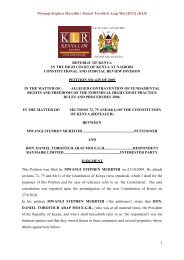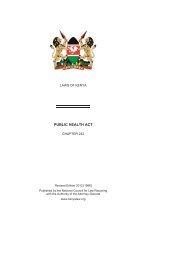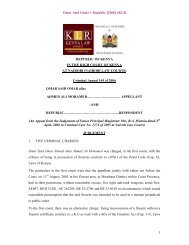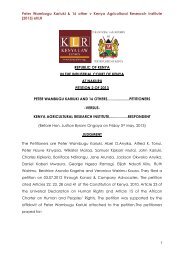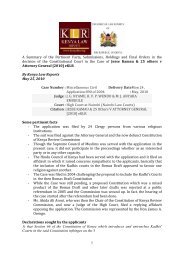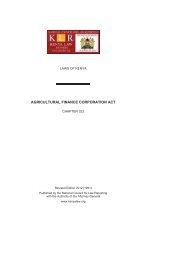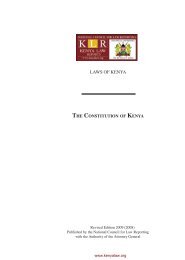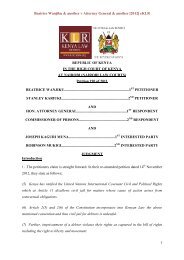JUDICIARY TRANSFORMATION FRAMEWORK - Kenya Law Reports
JUDICIARY TRANSFORMATION FRAMEWORK - Kenya Law Reports
JUDICIARY TRANSFORMATION FRAMEWORK - Kenya Law Reports
- No tags were found...
Create successful ePaper yourself
Turn your PDF publications into a flip-book with our unique Google optimized e-Paper software.
2Judiciary Transformation Framework , 2012 - 2016PrefaceThe important role that the Judiciary plays in advancing and stabilising modern democraciesis a matter of fact. The rule of law is an important determinant of socio-economicdevelopment. <strong>Kenya</strong>’s Judiciary, which is emerging from decades of chronic neglect andineffective delivery, must steadily remain conscious of its constitutional responsibilities, particularlyin superintending a new but still fragile social, political and economic transitionengendered by the Constitution.The promulgation of the Constitution of <strong>Kenya</strong>, 2010 heralded a new beginning for mostinstitutions. For the Judiciary, this call was even more urgent. It became imperative for theJudiciary to develop a mechanism for institutional renewal that would enhance public faithand confidence in it. This is the product of that process.The Transformation of the Judiciary must be seen as part of the transformation of <strong>Kenya</strong>nsociety commanded and envisaged by the Constitution. <strong>Kenya</strong>ns voted overwhelminglyin 2010 to establish a free, equal, prosperous and just social order. They entrenchedthis agenda in the Constitution and entrusted all government agencies with the task ofimplementing it. This Framework merely seeks to realize these constitutional ideals for theJudiciary.Its genesis, however, has a long historical basis, the constitutional moment only beingpropitious. The decline in public confidence, the disdain from other arms of government,and the dissipation of internal confidence within the Judiciary, are the enduring legaciesof the Judiciary’s own historical injustices – evidence of an institution that hungers for renewaland a restoration of its lost constitutional mission. The overweening influences of theExecutive created an enfeebled Judiciary, an arm of government strikingly reluctant to playits classical role in the defence and upholding of the constitutional principle of separationof powers. This capture by narrow interests created an institution plagued by corruptionand inefficiency – a veritable figure of scorn at odds with the public interest. While manymembers of its staff worked diligently under extraordinarily difficult circumstances, this hasbeen an institution in the vice-grip of a crisis of confidence.These pathologies saw the institution develop toxic insularity and cold insensitivity. It internalisedprivilege and entitlement, rather than service. It intoned authoritarianism ratherthan authority, thereby alienating the very public it was meant to serve and ingratiatingitself to the very arms it was supposed to check. Creeping dysfunctionality, unprofessionalismand corruption were the result; institutional ignominy, the effect.We have a duty to restore the Judiciary to its rightful constitutional and political place,and forge a new relationship with the public whose duty it exists to serve. The JudiciaryTransformation Framework (JTF) provides the basis and compass for the realization of thisobjective for the transformation of the Judiciary is not a choice; but a necessity. To fail totransform is to face an existential peril.Therefore, the transformation of the Judiciary must achieve at least three objectives: first, itmust reset the relationship between the Judiciary and other arms of government. Premisedon the principle of robust independence and constructive interdependence, the Judiciary
6Judiciary Transformation Framework , 2012 - 2016List of AbbreviationsCJCOECRJDCJICTJTFJTIKJSAKMJAKRAKWJANCAJNCLRPCAPJChief JusticeCommittee of ExpertsChief RegistrarDeputy Chief JusticeInformation & Communications TechnologyJudiciary Transformation FrameworkJudiciary Training Institute<strong>Kenya</strong> Judicial Staff Association<strong>Kenya</strong> Magistrates and Judges AssociationKey Result Area<strong>Kenya</strong> Women Judges AssociationNational Council on the Administration of JusticeNational Council for <strong>Law</strong> ReportingPresident of the Court of AppealPrincipal Judge
Judiciary Transformation Framework , 2012 - 2016 11ernment, the Judiciary must not only re-organize and restructure its institutional operations,but also wholly embrace the unique responsibilities bestowed upon it by the Constitution.As further detailed in the rest of this document, especially in Part III, the Transformation ofthe Judiciary entails several goals:a. Transforming the Judiciary to be an independent but complementary partner withthe other branches of government and to constructively collaborate with othercomponents of the State to make <strong>Kenya</strong> a constitutional democracy foundedon the values of the rule of law, human dignity, equity, social justice, humanrights, transparency and accountability;b. Transforming Court procedures, processes, organizational culture, and managementto re-orientate them towards a culture of responsive, friendly, and effectiveservice delivery accompanied by an integrated performance managementsystem to ensure accountability, improvement and transparency;c. Reordering the Judiciary’s administrative and judicial processes so that theformer supports the latter to enhance delivery of services; improve the speedof justice; and improve access to justice especially for the marginalized andtraditionally under-served communities;d. Reorienting the work environment in the Judiciary with a view to providing aconducive and affirming work place where all Judiciary employees are treatedfairly and with respect, and which offers career advancement possibilities forall without discrimination;e. Redesigning the institutional and administrative arrangements of the Judiciary tocreate a unified national institution with appropriate levels of devolution aimedat enhancing service delivery and empowering personnel in the outstations tocraft local visions and innovations for Court administration and local solutionsto local problems;f. Transforming the Judiciary’s relationship with other institutions of the justicechain and other stakeholders involved in court administration to better manageinter-dependencies and other matters of common interest; andg. Equipping the Judiciary to develop a robust, indigenous, patriotic and progressivejurisprudence that:i. Will give the country direction in dealing with historic perceptions and experiencesof marginalization and exclusion;ii. Will be aligned to international best practice especially in the area of humanrights; Enable it to play a constructive role in the consolidation of democracy;and,iii. Will contribute to the realization of a united, free, and prosperous <strong>Kenya</strong> wherehuman rights and freedoms are enjoyed by everyone without discrimination.
14Judiciary Transformation Framework , 2012 - 2016tive system – including a litigant’s charter – to provide information on courts’ jurisdiction,fees, and calendar; reducing the costs of accessing judicial services; promoting and facilitatingAlternative Dispute Resolution (ADR); establishing an office of Court Counsel in eachcourt to assist litigants who are representing themselves to understand court procedures;simplifying court procedures; and making the courts non-intimidating places – including establishinga customer care desk at every court station. The Judiciary will also set up specialcourts for children and other vulnerable groups. Small Claims Courts and Courts of PettyOffenders will also be established.To expedite the delivery of justice, the Judiciary will, among other things, develop anddeploy an electronic Case Management System; an integrated document managementsystem; embrace ICT and apply appropriate technology to enhance court efficiency andeffectiveness – including audio-visual recording and transcription of court proceedings; andensure appropriate staffing levels to deal with caseloads.In addition, to avoid disparities in sentencing between different judicial officers who sentencesimilar criminal defendants with similar background who commit similar offences,the Judiciary will spearhead the development and implementation of a Sentencing Policy.This policy will provide a coherent sentencing structure based on the principles of fairness,justice, proportionality and commitment to public safety. It will also remove arbitrarinessin sentencing and enhance public confidence in our criminal justice system. Similarly, theJudiciary will develop and implement Guidelines for the Administration of Bail and Bondfor the fair and orderly administration of the constitutionally guaranteed right to bail. Inpartnership with other relevant agencies, the Judiciary shall, also, expand the Legal AidScheme.3.1.2 KRA 2: People-Centredness and Public EngagementArticle 10 of the Constitution establishes public participation as one of the national principlesof governance. Indeed, this principle is threaded through the entire Constitution. Thisfundamental principle connotes and reaffirms the notion that the people are sovereign andtherefore must have a say in the running of the affairs of the various constitutional institutionsand offices, including the Judiciary.The Judiciary has been insular and remote both in its poise and processes giving rise tograve misunderstandings of how it runs its affairs. As a result, public confidence in the justicesystem has been greatly undermined.The Judiciary will engage the public in the administration of justice at various levels. It willdevelop and implement a structured approach to the achievement of successful public information,education and communication strategies as well as those for re-branding of theJudiciary. Open Days, Judicial Marches, Public and Student Visitation programmes will beinitiated and institutionalised to close this public distance. The Chief Justice will give an AnnualState of the Judiciary Address. For the avoidance of doubt, open court proceedingswill be the norm and chamber hearings the exception. Robust Bench-Academy and Bar-Bench programmes will also be initiated. An elaborate media and communication strategywill also be developed and implemented.Further, the Judiciary has established and will expand the Office of the Ombudspersonto receive and deal with public complaints. An internet-based and SMS Code complaints
Judiciary Transformation Framework , 2012 - 2016 17resentative from the Tribunals; one representative from the <strong>Kenya</strong> Magistrates and JudgesAssociation (KMJA), <strong>Kenya</strong> Judicial Staff Association (KJSA), and one representative eachfrom the Directorates and Registrars, will be the principal management organ of the entireJudiciary. The Judicial Service Commission (JSC) will play its constitutionally and statutorilydefined oversight role.Improving the work environment will require enhanced budgeting capacity, prudent financialmanagement systems and modern working tools and equipment. To this end, the Judiciaryhas already established the Judiciary Fund and developed regulations to govern itsoperations. It now plans, in an accelerated manner, to build the capacity of the Judiciaryto manage this Fund in an efficient, accountable, and transparent manner for the benefitof the <strong>Kenya</strong>n people. We shall institutionalize results-based budgeting, financial managementand accountability.The primary responsibility for the successful and sustainable transformation of the Judiciaryrests with its leadership, management and staff at all levels and in all capacities. A clearand robust organizational design; a dynamic leadership and management team; and acompetent and motivated staff are conditions necessary for a successfully transformedJudiciary and in this Framework period, all this will be undertaken. Additionally, the Judiciaryshall establish a devolved internal Disciplinary Mechanism with fair administrativeprocedures. To incentive and reward innovation and productivity, the Judiciary shall alsoestablish a Judiciary Award Scheme. Finally, the Court Inspectorate Unit shall be revivedand operationalized.3.2.3 KRA 6: Organizational StructureThe current organizational structure is highly centralized and concentrated. The structuraland operational relationship between the judges, magistrates, registry, and administrativestaff is dense, unclear and incomprehensible. There is a lack of clarity in reporting lines;there are no terms of reference/ job descriptions for officers upon recruitment nor are thereinduction programmes. Vertical and horizontal accountability systems are also lacking;judicial and administrative functions are fused. The Judiciary’s organizational structureis convoluted in form and outlook thus impairing quality decision making and location ofauthority and responsibility.This Framework will bring organizational clarity to this structure by, first, decentralisationof both judicial and administrative offices and functions, where appropriate. For example,the Judiciary shall devolve the human resources and budgeting and finance functions toseventeen identified regions throughout the country. Similarly, the Court of Appeal willnow be established in all major towns. In the same vein, the Judiciary will re-engineer itsorganizational structure to establish clear units of responsibility, clear reporting lines andclear demarcation of territory and accountability. Every staff recruited, from judges andmagistrates, to judicial staff, will undergo a formal induction process and will have formaljob descriptions. A continuous learning and training programme will be institutionalisedat the JTI.In this area, the Judiciary proposes operational structures that will define the roles andmandates of organizational units of the Judiciary – Courts, Court Stations, Divisions, andDirectorates - to facilitate effective steering, designing and implementation of the transformationand other ordinary programs. The focus under this result area is to establish clear
Judiciary Transformation Framework , 2012 - 2016 19and court rooms are not only unfriendly, they are also few and far between, which forcescitizens to walk long distances thus undermining the objective of access to justice. Manyyears of neglect and underinvestment, and a rather rapacious asset stripping tendencyhave seen the Judiciary lose a number of its courthouses and residential property. TheJudiciary has no known asset register, and the general custody of its assets is very weak.It has a weak technological orientation, on the one hand, and woefully low technologicalcapacity, on the other.An Infrastructure Development Master Plan and Strategy will be developed to acceleratethe construction and refurbishment of Courts; a Model Court House will be designed andbuilt; and an Asset Recovery and Registration Strategy will be executed. An elaborate ICTStrategic Plan will also be developed and implemented. The Judiciary will also establishan Infrastructure Inspectorate Department, under a Director, to oversee the massive infrastructuraldevelopment that it plans to undertake in the next ten years.3.3.2 KRA 9: Resourcing and Value for MoneyThe Judiciary has historically faced inadequate funding from the Government. The Constitutionnow grants it financial autonomy through the creation of the Judiciary Fund. Thisfund will be operationalised and an internal capacity created to manage it competently.The Judiciary will also institutionalize results-based budgeting, and establish a financialmanagement and accountability system. It will also strengthen the its procurement andaccounting capacity in order to meet regulatory standards and customer needs. Specifically,the Judiciary will develop and operationalize value-for-money standards, trails andindicators for forensic audit; training of procurement committees at the devolved units; anddevelop an annual procurement plan.Whereas the Judiciary plans to mobilize additional resources from development partners,especially in the short run, the objective of this Framework is to wean the Judiciary offdevelopment aid. <strong>Kenya</strong>’s justice system should, in the medium and long-term, be entirelyfunded by the taxpayer.3.4 Pillar FOUR: KRA 10: Harnessing Technology as an Enabler for JusticeThere is only one Key Result Area under this Pillar, namely Information and CommunicationTechnologies (ICT).ICT has an enormous potential to improve the administration of justice as a cross-cutting imperativefor the pillars of transformation identified in this framework: People/ User-FocusedDelivery of Justice; Internal Human Resource Capacity; and Infrastructure and Resources.Properly harnessed and deployed, ICT can facilitate speedier trials and enhance the efficiencyand effectiveness of administrative processes through data management, dataprocessing and secure archiving of information while guaranteeing more transparencyand fairness in the adjudication of cases and facilitating internal and external communication.The Automation of Courts also has the potential to enhance public confidence in thejudicial process by minimizing the risk of misplacement or loss of court files.The Judiciary has had very limited adoption and utilization of information and communicationtechnologies. One of the key challenges is the failure to properly harness anddeploy ICT, including developing the required ICT infrastructure and computerizing the
22Judiciary Transformation Framework , 2012 - 20165.0 RESULTS-BASED MATRIXPILLAR 1: People/User-Focused Delivery of JusticeKey Result Area 1: Access to, and Expeditious Delivery of, JusticeStrategicObjectiveTo provideequitableaccess tojustice forallStrategies Key Actions/Initiatives Strategy - level Indicators ofSuccessImprove physical accessto courts (and reduce distanceto courts) – See KRA8• Build new courts,based on modelcourt design guide• Provide mobilecourts• Ensure all courtsare accessible tocourt users andaccommodate theneeds of personswith disabilities• Use ICT tools (KRA10) to provideaccess to courtservices withoutrequiring aphysical presenceImproved physical access to courtsas represented by:• number/usage of newcourts & mobile courts• each court station has alinked mobile court• extent of use of ICT services• reducing average distanceto courtsImprove functional accessto courts and court services• Establish specialcourts for childrenand othermarginalised andvulnerable groups• OperationaliseSmall Claims courts• Simplify courtprocedures toreduce costs• Develop aLitigants’ Charterto provideinformation ofcourt jurisdiction,fees and calendar• Provide customercare desks at everycourt station• Establish the Officeof Court Counselas a one-stop shopfor information topro se litigantsImproved functional access tocourts as represented by:•number/usage of special courts &small claims courts• movement in caseload• litigant and public satisfactionwith court services andoverall court security• extent of use of ICT servicesIncreased use of ADR, plus a reduced number of court hearings
24Judiciary Transformation Framework , 2012 - 2016PILLAR 1: People/User-Focused Delivery of JusticeKey Result Area 1: Access to, and Expeditious Delivery of, JusticeStrategicObjectiveStrategies Key Actions/Initiatives Strategy - level Indicatorsof SuccessUtilise technology generallyto accelerate courtproceedings (see KRA10)Simplify court procedures• Acquire recordingand transcriptionsystems for courtproceedings• Provide judicialofficers with theICT tools necessaryto operate inan increasinglytechnologicallydrivenenvironment• Introduce audiovideo-teleconferencing (Tele-Justice)• Deploy workflowtools to improve themanagement of thecourt process• Continuously assessstaff capacityto ensure that itadequately meetsthe caseloaddemand• Improve clarity ofcourt proceduresso that pro selitigants maymore effectivelyparticipate in thecourt process• Produce a “simpleindex” of courtrules to enhanceusability foremployees and thepublic• Ensure courtprocedures aretranslated into allnational languagesReduced case cycle timeand reduced case backlogIncreased litigant and publicsatisfaction with courtprocesses
Judiciary Transformation Framework , 2012 - 2016 25PILLAR 1: People/User-Focused Delivery of JusticeKey Result Area 2: People-Centredness and Public EngagementStrategicObjectiveStrategies Key Actions/Initiatives Strategy - level Indicators ofSuccessTo improve publicconfidence in(and the imageof) the Judiciaryby positivelyengaging thepublic and enhancingpublicawarenessDevelop and execute ainformation, educationand communicationsstrategy directed at thegeneral public• Develop overallIEC strategy andIEC tools andmechanisms• Develop a mediastrategy that alsocovers social media• Developappropriatecollaborationand partnershipframeworks withprivate sector andcivil society forpublic engagementDisseminate IECmaterials on judicialservices, includingofficial publicationsand reports• Develop a Litigant’sService Charter• Establish the Officeof Court Counsel asa one-stop shop forinformation to thepublicImproved public knowledge andawareness of court proceduresGreater satisfaction with courtservicesEstablish public-facingmechanisms toengage the generalpublic• Establish CustomerCare desks at eachcourt station• Establish PublicInformation kiosks atstrategic locations• Use ICT tools (see KRA10) to communicate tothe public and allowthe public to accessinformation• Hold Open Days andJudicial Marches• Implement publicoutreach programmese.g. sensitisationsessions, “colloquiawith the public”, focusgroupsImproved public knowledge andawareness of court proceduresGreater satisfaction with courtservices
28Judiciary Transformation Framework , 2012 - 2016PILLAR 1: People/User-Focused Delivery of JusticeKey Result Area 3: Stakeholder EngagementStrategicObjectiveStrategies Key Actions/Initiatives Strategy - level Indicators ofSuccessdialogue,collaborationand partnershipframeworks withprivate sector andcivil society (whoare also in NCAJ –see below)Operationalise theNational Council forthe Administrationof Justice at nationallevel• Establish formalinstitutionalarrangementsfor NCAJoperations (subcommittees,technicalworking groupsetc)• Develop NCAJMedium-TermOperationalPlan andAnnualWorkplans fromstakeholderengagementstrategy• ImplementNCAJ activitiesEffective and efficient institutionalframework (NCAJ)supporting stakeholder engagementat the nationallevelOperationaliseCourt User Committeesat station level• Establisha modelinstitutionaland operatingframework forCourt UserCommitteesto be rolledout across thecountry• Develop andgazette CourtUser Committeeguidelines• Set upCourt UserEffective and efficientinstitutional framework(Court User Committees)NCAJ) supportingstakeholder engagementat the devolved, stationlevel
Judiciary Transformation Framework , 2012 - 2016 31PILLAR 2: Transformative Leadership and Professional, Motivated StaffKey Result Area 4: Philosophy and CulturentStrategicObjectiveStrategies Key Actions/Initiatives Strategy - level Indicators ofSuccessgovernancein theconstitution,as well as thePublic OfficerEthics ActTo promoteculture changein Judiciary thataccords withits transformedmandateExecute a CultureChange Strategyas part of ChangeManagement Strategy(see KRA 5)• Envision NewCulture• Prepare CultureChange Visionand ReadinessAssessment• Develop andImplementCulture ChangePlan (as partof ChangeManagementPlan)• Culture changeplan in place aspart of ChangeManagement• Culture changeprogrammesuccessfullyimplementedPILLAR 2: Transformative Leadership and Professional, Motivated StaffKey Result Area 5: Leadership and ManagementStrategicObjectiveStrategies Key Actions/Initiatives Strategy - level Indicators ofSuccessTo establish aLeadership andManagementFramework for theJudiciary that supportsTransformationon a day-todaybasisDevelop and launchLeadership andManagement Guidelines• Performleadership andmanagementaudit• Benchmarkwith exemplaryjurisdictions• Developleadership andmanagementguidelines andpilot at thecentre• Developmentoringprogramme• Devolveleadership andmanagementguidelines• Implement• Leadership andmanagementguidelinesdeveloped,launched,piloted at thecentre anddevolved to thestation level• Leadership andmanagementprogrammessuccessfullyimplemented
Judiciary Transformation Framework , 2012 - 2016 35PILLAR 2: Transformative Leadership and Professional, Motivated StaffKey Result Area 5: Leadership and ManagementStrategicObjectiveStrategies Key Actions/Initiatives Strategy - level Indicators ofSuccessPerform anoverall JobEvaluation• Based on thejobs and jobdescriptions in thenew structure (SeeKRA 6), carry outan overall JobEvaluation as abasis for guidingpolicy decisionson (relative) payin relation toactual work done/responsibilitiesheld• Job evaluationexercisesuccessfullycompleted andjob gradingrecommendationsapproved by theJSCDevelopremunerationand rewardmechanismsthat promoteboth individualand team basedperformance• Review currentremunerationand rewardmechanisms• Develop newremunerationand rewardmechanismslinked to IPMAS• Newremunerationand rewardmechanismsdeveloped andapproved by theJSCDevelopsound InternalDisciplinaryMechanisms• Identify mattersthat could beresolved quicklyinternally withoutcompromisingfairness• Develop InternalDisciplinaryMechanism tohandle suchidentified matters• Sound InternalDisciplinaryMechanismestablished and inplaceTo optimiseHR Staffingin theJudiciaryPerform HRinventoryof allJudicialStaff• Performinventory of staff(permanent vs.temporary)• Perform basicknowledge andskills audit of allstaff• Perform specificKnowledge andskills audit forall staff againstcurrent jobsoccupied• ComprehensiveHR inventory,includingknowledgeand skills audit,successfullycompleted
Judiciary Transformation Framework , 2012 - 2016 37PILLAR 2: Transformative Leadership and Professional, Motivated StaffKey Result Area 6: Organization StructureStrategicObjectiveStrategies Key Actions/Initiatives Strategy - level Indicators ofSuccess• Establish staffing needs(skills and quantum)to support the neworganizational structureDevelop individualcourt, courtstation, divisionand directoratestructuresDevelop job descriptionsfor allpositions fallingwithin the overallorganizationalstructure• Based on the overallnational and devolvedstructures, developorganizationalstructures forindividual units at bothnational and devolvedlevel• Perform job analysisto identify the scopeand scale of jobsenvisaged by the newnational and devolvedstructures for eachorganizational unit• Revise the staffestablishment (withJSC approval) for alljobs in the structure• Review statusof existing jobdescriptions andupdate them asneeded to reflectnew organizationalstructure• Develop jobdescriptions for alljobs created by thenew structure• Organizationalstructures for courts,court stations, divisionsand directoratesestablished• Revised staffestablishmentapproved by the JSC• Job descriptionsdeveloped forEVERY position in theJudiciaryPILLAR 2: Transformative Leadership and Professional, Motivated StaffKey Result Area 7: Growth of Jurisprudence and Judicial PracticeStrategicObjectiveStrategies Key Actions/Initiatives Strategy - level Indicators ofSuccessTo establishan overallframeworkfor training,research,bench-Developthe JudicialTrainingInstitute as theJudiciary’sthink tank• Implement the JTIStrategic Plan• JTI recognition as acentre of excellence
40Judiciary Transformation Framework , 2012 - 2016PILLAR 3: Transformative Leadership and Professional, Motivated StaffKey Result Area 8: Physical InfrastructureStrategicObjectiveStrategies Key Actions/Initiatives Strategy - level Indicators ofSuccess• Prepare Court DesignGuide• Prepare CourtMaintenance GuideDevelop ModelCourts (prototype)• Locate and BuildModel High Court• Locate and BuildModel MagistratesCourt• Locate and BuildModel Children’sCourtModel Courts builtRefurbish andRenovate ExistingCourts (all types)• Prioritise CourtRenovation based onInventory (MasterPlan)• Renovate Courtsaccording to MasterPlanCourt Renovationscarried out in linewith Master PlanBuild New Courts(all types)• Prioritise New CourtConstruction basedon Selection andInvestment Criteria(Master Plan)• Build New Courts perMaster PlanNew CourtConstruction carriedout and completed inline with Master PlanMaintain Courts• Carry outregular CourtMaintenancebased onguidelines andplansCourtMaintenanceRecords showregular maintainin line withguidelinesTo provideadequateworkingtools andotherInfrastructureDevelop comprehensiveAssetManagementSystem• Establish national andstation-level AssetRegisters• Establish national andstation-wide AssetManagement andTracking SystemAsset Registers andAsset Management &Tracking Systems inplace
42Judiciary Transformation Framework , 2012 - 2016PILLAR 3: Adequate Infrastructure and Sufficient ResourcingKey Result Area 9: Resourcing and Value for MoneyStrategicObjectiveStrategies Key Actions/Initiatives Strategy - level Indicators ofSuccessReview and RevampJudiciaryPFM Processes• Develop JudiciaryPFM Strategy• StrengthenPlanning, Budgeting,Procurement, BudgetExecution, Cash andAsset ManagementProcesses at nationaland station level• Develop RevenuePlanning andManagement Systemsat national and stationlevel• Develop Tracking,Monitoring,Accounting, Reportingand ExternalAccountability Systemsat national/stationlevelJudiciary PFMprocesses reviewed,revamped anddeveloped in line withthe Judiciary PFMStrategyEstablish RegularMedium-Term Planningand BudgetingFramework• Develop RollingMedium-TermOperational Plansbased on JTF andStrategic Plan• Translate Plans intoMedium-Term BudgetStatements, andAnnual BudgetsRegular Medium-Term Planningand BudgetingFramework for theJudiciary is in placeand fully operationalTo mobiliseresourcesfor successfulimplementationofthe JTFMobilise GoK Resourcesannually• Negotiate Share ofNational Resourcesat beginning of MTEF(BOPA)• Present and JustifyResource Estimates toParliament (BudgetCommittee)GoK resourcessuccessfully mobilisedon an annual basisRaise Internal ResourcesAnnually• Develop andImplementParliamentapprovedRevenue PlansInternal revenueresourcessuccessfullyraised annually
Judiciary Transformation Framework , 2012 - 2016 43PILLAR 3: Adequate Infrastructure and Sufficient ResourcingKey Result Area 9: Resourcing and Value for MoneyStrategicObjectiveStrategies Key Actions/Initiatives Strategy - level Indicators ofSuccessRaiseResources fromDevelopmentPartners basedon Multi-YearAgreements• Establish JTFalignedMulti-Year FinancingAgreement(s)withDevelopmentPartners• NegotiateAnnualFundingAllocationsbased on Multi-Year FinancingAgreements• Developmentpartner resourcecontributionssuccessfullymobilised in linewith FinancingAgreementsTo ensure thatthe JudiciaryachievesValue forMoney (VFM)in the use of allof its resources,regardlessof source ormethod offundingEstablisha VFMPolicy andArrangements• Establish VFM policy• Ensure Judiciary PFMprocesses and IFMISsystems have inbuiltchecks to provide VFMassurances as regardsthe economy, efficiencyand effectiveness ofresource useVFM Policy andArrangementsestablished and fullyoperationalAlign with GoKProcurementand FinancialManagementRegulations• Ensure that Judiciaryrules are aligned withGoK procurement andfinancial managementregulations, subject to thefinancial independenceaccorded to the JudiciaryFundTransparent JudiciaryProcurement andFinancial ManagementRules fully alignedComply withdevelopmentpartnerProcurement(and, ifapplicable,FinancialManagement)regulations• Ensure that JudiciaryProcurement rulesare aligned withdevelopment partner,subject to VFMconsiderations and therules of the JudiciaryFundTransparentJudiciaryProcurementand FinancialManagement Rulesfully aligned
44Judiciary Transformation Framework , 2012 - 2016PILLAR 3: Adequate Infrastructure and Sufficient ResourcingKey Result Area 9: Resourcing and Value for MoneyStrategicObjectiveStrategies Key Actions/Initiatives Strategy - level Indicators ofSuccessUp hold the JudiciaryCode of Ethicsand Conduct• Develop andenforce mechanismsto ensure compliance• Judiciary Codeof Ethics andConduct fullyoperationalisedTo ensurethat theJudiciaryachievesValue forMoney(VFM) inthe use ofall of itsresources,regardlessof sourceor methodof fundingEstablish a VFMPolicy and Arrangements• Establish VFM policy• Ensure Judiciary PFMprocesses and IFMISsystems have inbuiltchecks to provideVFM assurancesas regards theeconomy, efficiencyand effectiveness ofresource useVFM Policy andArrangementsestablished and fullyoperationalAlign with GoKProcurement andFinancial ManagementRegulations• Ensure that Judiciaryrules are aligned withGoK procurement andfinancial managementregulations, subjectto the financialindependenceaccorded to theJudiciary FundTransparentJudiciaryProcurementand FinancialManagementRules fully alignedComply with developmentpartner Procurement(and, ifapplicable, FinancialManagement)regulations• Ensure that JudiciaryProcurement rules are alignedwith development partner,subject to VFM considerationsand the rules of the JudiciaryFundTransparent JudiciaryProcurement andFinancial ManagementRules fully aligned
46Judiciary Transformation Framework , 2012 - 2016PILLAR 4: Harnessing Information and Communication Technology (ICT) for JusticeKey Result Area 10: ICT as an EnablerStrategicObjectiveStrategies Key Actions/Initiatives Strategy - level Indicators ofSuccessInteractive VoiceResponse System(IVRS)• Establish Tele-Justice System(Teleconferencing)Upgrade andimprove hardwareinfrastructure• Procure ICThardware(desktops, laptopsetc) in line with ICTplan• Procure ICTperipherals(printers, copiers,scanners, externaldrives etc) in linewith ICT planHardwareinfrastructureimproved andupgraded inline with the ICTStrategic PlanEnhance systemscontrol andsecurity• Procure ICTperipherals(printers, copiers,scanners, externaldrives etc) in linewith ICT plan• Establish NetworkSecurity System• Establish SecuritySystem forJudiciary DataCentre• Procure Hardware& SoftwareSecurity Tools forUsersSystems Controland Securityenhanced inline with the ICTStrategic Plan
Judiciary Transformation Framework , 2012 - 2016 47PILLAR 4: Harnessing Information and Communication Technology (ICT) for JusticeKey Result Area 10: ICT as an EnablerStrategicObjectiveStrategies Key Actions/Initiatives Strategy - level Indicators ofSuccessDevelopICT disasterrecoveryframework• Develop andImplementDisaster RecoveryFramework• Establish JudiciaryData CentreDisasterRecoveryFramework andArrangementsestablished inline with the ICTStrategic PlanTo adoptautomationand e-systemsin judicialprocessesAutomateand establishe-systemsfor CourtManagement• PaperlessSupreme Court• Digitise CourtRecords• EstablishElectronicBillboards inCourts• Procure PublicAddressSystemsCourtmanagementsystemsautomated asplannedAutomateand establishe-systemsfor CaseManagement• Establish ComprehensiveCase ManagementSystem (CCMS)• Develop citizenfriendlyICT portals andchannels• Establish SMS InquirySystems for Litigants andthe Public• Establish Recording andTranscription Systemsfor Court Proceedings• Establish JudgementDelivery TrackingDeviceCase managementsystems automated asplannedTo adoptautomationande-systems inadministrativeprocessesAutomateand integratesystems foradministrativesupport• Establish JudiciaryIntegrated InformationManagement System(JIIMS)• Establish IntegratedFinancial ManagementInformation System(J-IFMIS)Administrative supportsystems automated asplanned
Judiciary Transformation Framework , 2012 - 2016 49NOTES
50Judiciary Transformation Framework , 2012 - 2016NOTES
REPUBLIC OF KENYATHE <strong>JUDICIARY</strong>THE CHIEF REGISTRAR,SUPREME COURT OF KENYA,CITY HALL WAY,P. O. BOX 30041-00100,NAIROBI, KENYA.info@judiciary.go.keTel: +254-20-2221221Fax: +254-20-2318172



